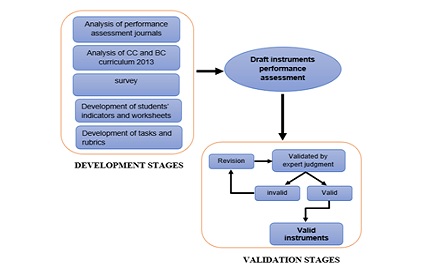
Development of Performance Assessment Instruments to Measure Students’ Scientific Thinking Skill in the Quantitative Analysis of Acetic Acid Levels
Abstract
This study aims to develop good quality performance assessment instrument that can be used to measure students’ scientific thinking skills. The research method used is Development & validation The study describes the 5 stages of instrument development, namely the analysis of performance assessment journals, analysis of Core Competency and Basic Competency on 2013 curriculum, field surveys, development of indicators and student worksheets, as well as target skills and rubric development. The developed instrument consists of 33 target skills (experimental problem solving) and 9 target skills (quantitative literacy). The expected value in this research is the accuracy of students in performing practical work. In the validity test, it is obtained a CVR value of 1.00 on 42 developed target skills, so that the instrument was declared as valid. Based on the analysis of research data, it can be concluded that the developed performance assessment instruments have good quality to measure students' scientific thinking skills.
Keywords
Full Text:
PDFReferences
Adam, K., & Wieman, C. (2010). Development and Validation of Instrument to Measure Learning of Expert-Like Thinking. International Journal Science education. 1(1). 1-24
Chen, H. J., She, J. L., Chou, C. C., Tsai, Y. M., & Chiu, M. H. (2013). Development And Application Of A Scoring Rubric For Evaluating Students’ Experimental Skills In Organic Chemistry: An Instructional Guide For Teaching Assistants. Journal of Chemical Education, 90(10), 1296-1302.
Cody, W. S. (2000). Designing an Effective Performance Task for the Classroom. English Teachers' Journal, 53, 15-23.
Dewi, I. & Riandi. (2015). Analisis Kemampuan Berfikir Sains Siswa SMP Kelas VII di Kota Sukabumi Melalui Pembelajaran Berbasis Masalah pada Tema Pemanasan Global. Prosiding Seminar Nasional Fisika, 4, 151-156.
Firman, H. (2013). Evaluasi Pembelajaran Kimia. Bandung: Jurusan Pendidikan Kimia FPMIPA UPI.
Firman, H. (2018). Assessment Pembelajaran Kimia. Bandung: Jurusan Pendidikan Kimia FPMIPA UPI.
Fitriyati, I., & Munzil, M. (2017). Penerapan Strategi Pembelajaran Inkuiri Terbimbing Berbantuan Media untuk Meningkatkan Keterampilan Berpikir Ilmiah Siswa pada Pembelajaran IPA SMP. Jurnal Penelitian Pendidikan IPA, 1(1), 1-6.
Harsh, J. A. (2016). Designing performance-based measures to assess the scientific thinking skills of chemistry undergraduate researchers. Chemistry Education Research and Practice, 17(4), 808-817.
Jo, I., & Bednarz, S. W. (2014). Developing pre-service teachers' pedagogical content knowledge for teaching spatial thinking through geography. Journal of Geography in Higher Education, 38(2), 301-313.
Karviyani, S., Rosilawati, I., & Efkar, T. (2015). Pengembangan Instrumen Asesmen Kinerja Praktikum pada Materi Titrasi Asam Basa. Jurnal Pendidikan dan Pembelajaran Kimia, 4(1), 83-94.
Khun, D. (2004). What is scientific thinking and how does it develop? (second edition). Columbia: Balckwell Publishing
Kurniawan, N., Masriani., & Muharini, R. (2016). Deskripsi Keterampilan Psikomotorik Siswa Kelas Xi Ipa Smas Mujahidin Pontianak Pada Praktikum Titrasi Asam-Basa. Jurnal Pendidikan dan Pembelajaran, 6(8), 1 – 6.
Nahadi, M., Anwar, S., & Pertiwi, H. R. (2016). Pengembangan Instrumen Penilaian Kinerja Pada Pembelajaran Titrasi Asam Basa Dengan Metode Praktikum. Jurnal Pengajaran MIPA, 21(1), 35-41.
Nahadi, N., Firman, H., & Khilda, K. (2017). Pengembangan Instrumen Penilaian Diri Dan Penilaian Teman-Sejawat Untuk Menilai Kinerja Siswa Smk Pada Praktikum Kimia. Jurnal Penelitian Pendidikan Kimia: Kajian Hasil Penelitian Pendidikan Kimia, 4(2), 111-118.
Ningtyas, F.K., & Agustini, R. (2014). Pengembangan Instrumen Penilaian Kinerja Siswa Untuk Mengases Keterampilan Proses Dalam Praktikum Senyawa Polar Dan Non Polar Kelas X SMA. UNESA Journal of Chemical Education. 3(3), 169-175.
Nuraeni, E., Redjeki, S., & Rahmat, A. (2017). Perkembangan Literasi Kuantitatif Mahasiswa Biologi Dalam Perkuliahan Anatomi Tumbuhan Berbasis Dimensi Belajar. Jurnal Ilmu Pendidikan, 21(2), 127 – 135.
Prades, A., & Espinar, S. R. (2010). Laboratory assessment in chemistry: an analysis of the adequacy of the assessment process. Assessment & Evaluation in Higher Education, 35(4), 449-461.
Speth, E. B., Momsen, J. L., Moyerbrailean, G. A., Ebert-May, D., Long, T. M., Wyse, S., & Linton, D. (2010). 1, 2, 3, 4: infusing quantitative literacy into introductory biology. CBE—Life Sciences Education, 9(3), 323-332
Timostsuk, I. (2015). Domains of science pedagogical content knowledge in primary student teachers’ practice experiences. Procedia-Social and Behavioral Sciences, 197, 1665-1671.
Wilson, F.R., Pan, W., & Schumsky, D. A. (2012). Recalculation of the critical values for Lawshe’s content validity ratio. Journal Measurement and Evaluation in Counseling and Development, 45(3), 197 – 210.
Zainul, A. (2001). Alternatif Assessment. Jakarta: Universitas Terbuka
DOI: http://dx.doi.org/10.31258/jes.4.3.p.459-468
Refbacks
- There are currently no refbacks.
Copyright (c) 2020 Dea Rian Firmansyah, Nahadi Nahadi, Harry Firman

This work is licensed under a Creative Commons Attribution 4.0 International License.
Publisher: FKIP Universitas Riau












